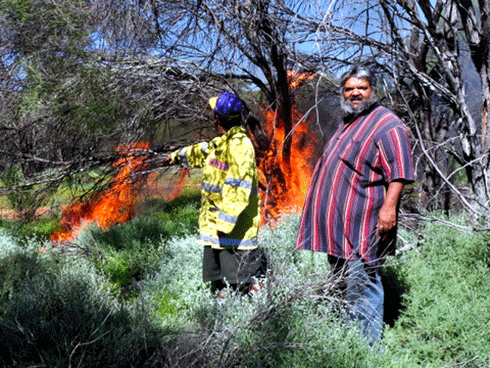
|
Published: 3 February 2014
Ngadju kala: the finely tuned science of traditional fire management
CSIRO has partnered with Western Australia’s Ngadju Conservation, Goldfields Land and Sea Council, and WA Department of Parks and Wildlife to produce a new fire management report that challenges common beliefs about Aboriginal burning practices in Australia.

|
|
Ngadju participating in a fire training day at Buldania Rocks. Les Schultz (right) warned participants that this fire was too high and would kill the wattles. Credit:
S Prober
|
Contrary to the common assumption that Aboriginal burning was widespread and frequent, the report, initiated by Les Schultz of Ngadju Conservation, shows that the Ngadju community from south-western Australia were highly selective in where they burned their country.
'Ngadju used fire as a cultural tool for looking after rockholes and grassy areas; for protecting important cultural sites and special plants such as water trees; for access and hunting; and for encouraging grasses.
‘The old growth woodlands were rarely burnt deliberately', says Les.
Among the key findings of the report are:
-
Extensive old growth woodlands were rarely burnt deliberately, because they take hundreds of years to recover.
-
Extensive sandplain shrublands were only occasionally burnt with planned fire. Mostly they burned naturally by wildfires that were allowed to take their course.
-
Ngadju used fire as a cultural tool for keeping the country clear around rockholes, for encouraging grasses in open grasslands and mallee, and to smoke out animals when hunting. These fires were often small, around 1 ha.
-
The Ngadju also used fire to protect important cultural sites and special plants such as water trees; and to maintain access along walking tracks and in coastal shrublands.
-
Other activities such as firewood collecting around the edges of woodlands and rockholes, and sweeping and scraping up litter around individual trees, were undertaken to help control wildfire.
-
These practices would have led to a fine-scale fire ‘mosaic’ over the top of the natural vegetation mosaic.
Ngadju country is of particular significance as it covers a large part of the 16 million ha Great Western Woodlands, the largest remaining area of intact Mediterranean-climate woodland on Earth.
The area is globally unique in that nowhere else do tall woodlands occur at as little as 250 mm mean annual rainfall, making fire management in the region important and challenging.
Another significant outcome of the report is that the documented knowledge will enhance Ngadju opportunities to be connected to and to work on country, informing the ecological management of the Great Western Woodlands.
The report documents the Ngadju’s understanding of local ecosystems and fire regimes, and highlights how the community would like to contribute to contemporary fire management in the region.
At the launch of the report, Les said: 'Today is a milestone for traditional and contemporary healthy country action planning in Ngadju country.
‘Our aim is that our children can come out of school and train as fire and biodiversity experts on their own country. We welcome and thank our partners for many years of contribution towards Ngadju empowerment.'
The collaboration was facilitated through the national Terrestrial Ecosystem Research Network (TERN).
Source: TERN



